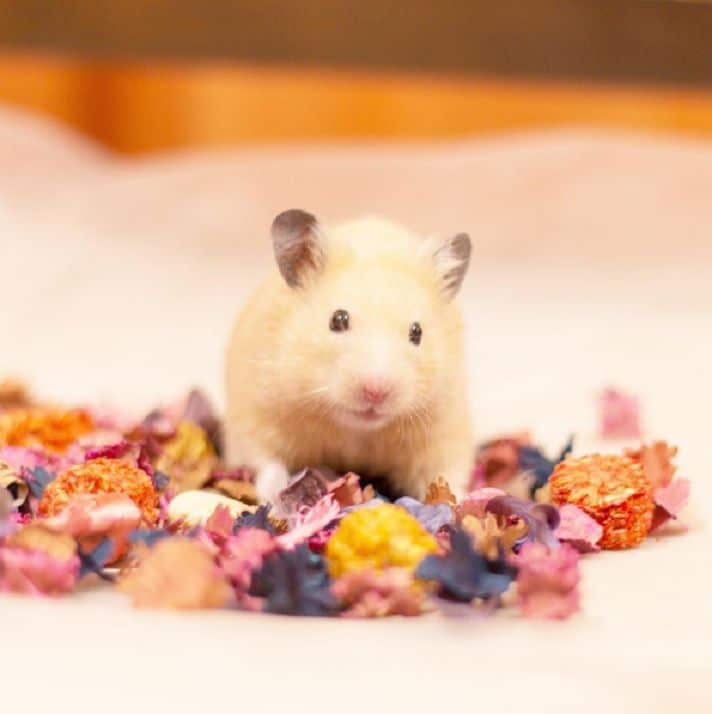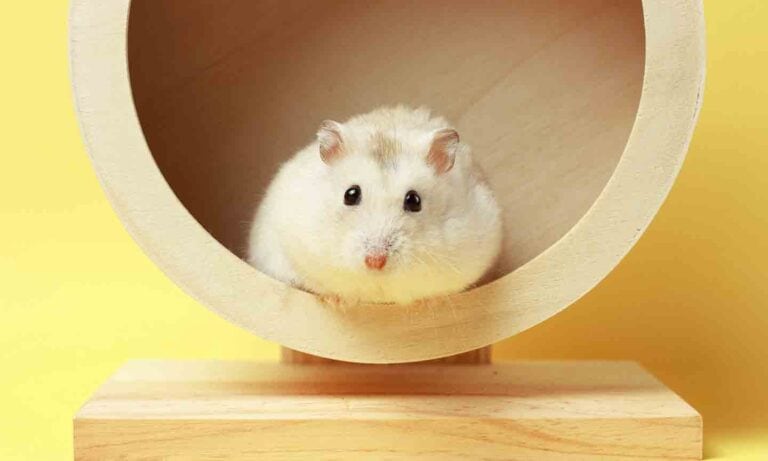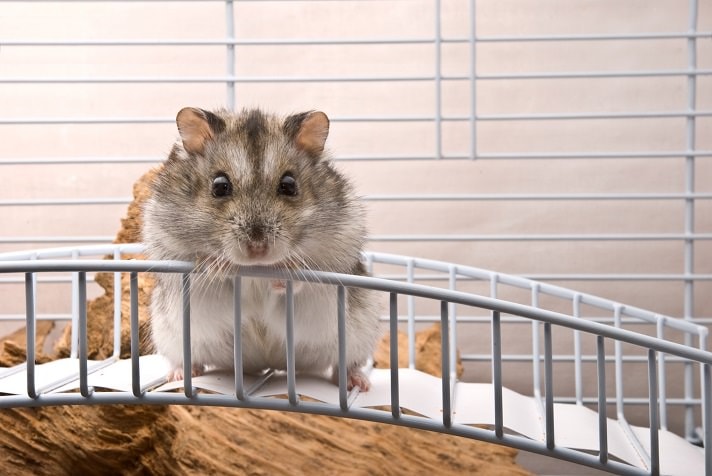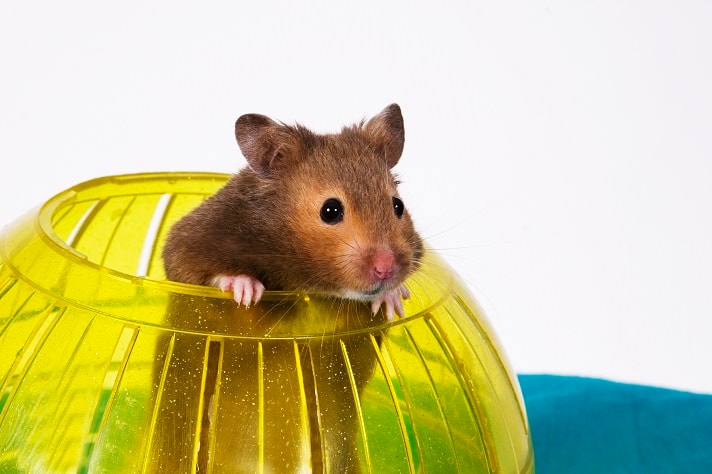Q.
I have a lovely, friendly 5- to 6-month-old Syrian Golden hamster (not sure about her age because she was a rescue, but it’s a fair guess). I love her completely, but now and then I have a little trouble going near her because of an awful smell. I’ve checked with all the experts I could find about diet and other cautions, and I’m pretty sure I’m doing everything right. She shows no sign of illness, loss of appetite or discomfort in any way. Recently I became especially worried because she seemed to have a discharge from her anal/genital region.
I live quite some distance from a veterinary hospital, and I’m not sure the local vets even cater to small pets. My cousin is a veterinarian, and she said it sounded to her like something that required immediate antibiotic treatment. But she admitted that she doesn’t know the first thing about hamsters (she’s a farm vet). As I say, everything about her seems normal, and she looks and acts like a totally healthy hamster. Should I be worried?
A.
A short while back I answered a question on why a hamster smelled of urine from someone who had trouble keeping their hamster clean and fresh-smelling for purely hygienic reasons. And solutions can be approached from many directions. But from what you describe your situation is different. And if my guess is correct, what I’m about to describe should sound very familiar.
You say that your hamster is a young female Syrian. This smell you’re noticing, is it quite strong and acrid, sort of musky and burnt? And does it seem to go away for a while and return about three to five days later? And here’s something that would definitely get your attention: When you’re noticing this smell, does your gentle girl seem just a bit jumpier, more sensitive? When you rub her lower back near her tail, does she stand still and sort of vibrate in place? That last is among the more remarkable behaviors in the world of hamsters. Finally, the discharge that you saw, was it off-white, and somewhat paste-like?
If these things sound familiar, I can set your mind to rest, as there’s likely nothing at all wrong with your pet. You’re seeing an absolutely natural biological function.
Now, you’re going to want to rule out any possibility of significant illness, and it seems you’ve begun to do that already. Look for healthy eyes, clear and bright. Her coat should be full, clean and have a soft sheen (this will, of course, vary for different varieties, but it’s easy to find examples of what a healthy hamster coat should look and feel like). Most importantly, is there anything unusual about her food intake or waste output? Is she eating properly? (Young female Syrians tend to be big hoarders, so it’s often difficult to judge the extent of their appetite.) Is she urinating regularly but not excessively, and are her stools sizable, dark and firm? All these things are crucial indicators of a hamster’s health. In your case it seems you’ve been paying very diligent attention to these factors, and all’s well.
So let me tell you what appears to be happening. As we all know, Syrian hamsters are solitary. They live entirely alone and only come into contact with one another in conflict or to propagate the species. Because the instinct is to be alone, to get a female to be receptive to a male’s attention there must be a great upheaval in her biological profile. It’s referred to with several terms but it’s commonly known as oestrus or being “in season” or “in heat.” Most young female Syrians go through it every three to five days. It’s when the female is fertile and ready for mating, and it’s one of nature’s more effective tools to ensure survival of the species. You may also notice that during oestrus your hamster will be a bit more restless and high-strung, a little fussier about her nest, a little more protective of her home. All of this is in the service of making her a better mom.
What disturbed you so was the appearance of what looked like an infectious discharge appearing around the genital area.
One reason I was so eager to answer your question is that you won’t see this answer often. Few, if any, books discuss it and as a result, caregivers are frequently startled and frightened by it. Not a few hamsters are brought to veterinarians, and not a few vets are bewildered by it themselves, as this is a completely benign, natural occurrence, and not a major topic of study.
The thick, whitish, viscous secretion is the cause of the awful smell, because it is the product of the awesome biological changes she’s undergoing internally. The substance may, in fact, facilitate the reproductive act. More importantly, when the female comes and goes for her foraging in the wild, she leaves some of this substance on the brush and earth surrounding her burrow, the unmarked hole in the ground that is the entrance to her home. With their astounding sense of smell, male Syrians may smell this strong scent for miles on the desert breeze. The tiny trace she leaves near the entrance of her underground home is like a giant billboard to the sensitive noses of males for miles around. It means for a very brief time, she’s ready and able to create life!
Now that’s a beautiful thing, right? But your hamster’s not going to be mating, so this marvelous biological process is serving no practical purpose except to do very un-beautiful things to your nose. I’m afraid there’s nothing that can be done to completely eliminate it while she’s young, but the good news is that it will certainly lessen as she matures and passes out of typical childbearing age. (Also, though it doesn’t apply in your case, in my experience hamsters who have given birth to a litter or two don’t exhibit it as much, because there’s no mathematical imperative in nature for one mother to give birth to many litters, but rather one or two healthy ones, in order to carry on the species).
You can dab away the secretion with a clean tissue, and it’s been confirmed that in most cases removing it physically diminishes the severity of the smell over time. (Flush that tissue, as the smell does not dissipate over time. And try not to get the smell on your hands, but if you do, dish detergent or antibacterial soap should help.) This is where behavioral changes in your “heaty” hamster actually work in your favor. It’s not always a sure bet, but you can often “mesmerize” a hamster in season. If you think about the significance of the event, and what needs to take place, there’s nothing in this world that is going to make one Syrian hamster stand still in the presence of another except an inescapable impulse from within. Nature happily provides this. It may take some practice, but when your hamster’s smell is particularly strong, try putting her on a flat surface and very gently petting her back near the base of her tail with your fingertips. She’ll very likely stand patiently still, indifferent to anything around her. Now you can clean her lower parts. This causes no harm to her, and the moment you stop stroking her back she’ll continue to go about her way as if it never happened. But this is nature’s commanding presence speaking through her, allowing it to be easier for her to carry on her kind.
So next time you smell that odor, you’ll know what you can do (though it’s not much), what it means (life!) and not to worry. And perhaps it will bring you two closer together, because in that moment you can pay your respects to her for representing the crucible of hamsterdom!
By: Martha Boden
Featured Image: ham.nappa/Instagram
Share:









